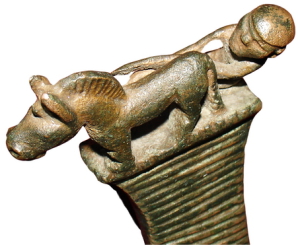Institute of Human Ecology of the Siberian Branch of the RAS, Kemerovo
(ivkovtun@mail.ru)
Key words: Ashvamedha, sacrifice, Indo-Aryans, Mitanni, arrow Rostovka, metallurgy of Seima-Turbino.
The article is devoted to the analysis of the knife’s pommel from the Seima-Turbino barrow Rostovka near Omsk. The phenomenon of metallurgy of Seima-Turbino communities changed dramatically the technological standards of bronze casting industry of the North Eurasia at the end of the 3rd millennium – first centuries of the 2nd millennium BC. But the problem of ethnical and linguistic affiliation has not been solved yet. The author suggests the existence of an Indo-Aryan component in the Seima-Turbino groupings. The evidence of such substrate is the informative meanings of the sculptural mise en scene of the knife from Rostovka. The parallels are drawn between the ornamentation of the tail and the mane of the horse from Rostovka on one hand and the mix of a Vedic source and a Mitanni image on the other hand. The meaning of the composition with a skier pulled by the horse correlates with the Ashvamedha.








